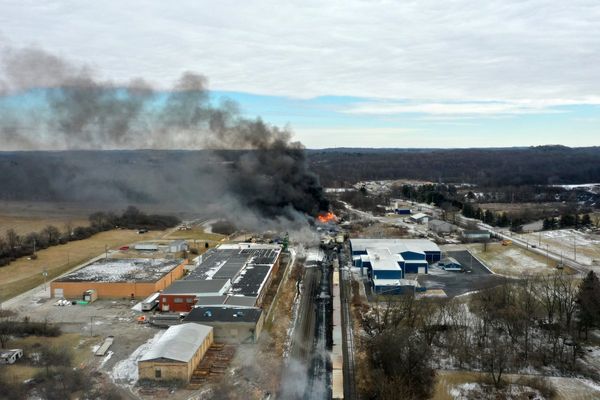
Day 1: Grosmont to Skenfrith (5.5 miles)
The castles of Grosmont, Skenfrith and White Castle lie west of the border. Just. For a millennium they’ve hunkered in that hinterland where England shoulders up against Wales. As we set off uphill from Grosmont there’s nothing more aggressive going on than a little haymaking, the hum of a distant tractor is masked by a brisk wind through oak leaves; but in the past there have been tensions. Building a castle – building three – is not, after all, an act of friendship. Strictly speaking, though, it wasn’t the English who flexed their muscles here but the French; Normans, who, in the wake of conquest, sat down on the doorsteps of Welsh chieftains and made themselves at home.
Hard to blame them. The steep pull out of Grosmont achieved, we stop and gaze east across a landscape so verdant it drenches the eyes. The village below shines in the sun and the River Monnow, which marks the border, slides sleepily through it. Beyond lies England, somewhat shadowed.
“It looks French,” says Pam, of Grosmont Castle’s ruined towers.
“It is,” says Mike.
The grass is warm as I lie back in it, and smells of honey. If you’ve walked in summertime Normandy, you’ll recognise the scent. Three days of walking ahead. Good company, fine weather. I smile. If those Frenchmen relished this place as I do, no wonder they built castles.
On we go. Mid-afternoon approaches and today’s destination lies a gentle five miles away. The miles are warm, honeysuckled and pass easily beneath our feet. Fields here are small, hedgerowed and scattered with buttercups. We traverse them over stiles that Mike’s dog, Fflos, scrambles over. “She’s an English shepherd dog,” Mike explains. “Though the breed’s more American now, taken over on the Mayflower.”
So, none of us is Welsh – not even the dog. Mike hails from Worcestershire but has made his home here. Pam, an American, fell in love with Wales 40 years ago and returns every summer. I live a half hour into England, and spend a lot of time looking west. We’re where we want to be right now and, as we descend towards Skenfrith’s ruined red sandstone castle, contentment settles.
John Morgan, now he was a Welshman, and the last governor of the Three Castles lordship for the English duchy that held it in his day. He died in 1557 and rests in the 13th-century church of St Bridget, which we wander to after scouring the castle at Skenfrith. His likeness, wide-eyed and bearded like a druid, is incised into his tomb-top, so that it appears as if he lay down upon it 500 years ago and has been sinking into stone ever since. He seems happy enough, confident of remaining. I touch his face in farewell, sorry we have only three days here, against his eternity.
Annie Garthwaite
Day 2: Skenfrith to White Castle (7 miles)
White Castle is the one I’m most excited about Pam and Annie seeing, but I want it to be the glorious finale to a solid day’s walking, so when we drop a car there first thing, I forbid them to look and spirit them away back to Skenfrith. The drive between the two takes 12 minutes; to walk it will take four or five hours. Landscape that rushes by through a windscreen will gradually unfold, teased into textures unseen by drivers. Contours too, of course – and there’s no shortage of those.
Today we hack west, deeper into Cymru. The rich red earth of Hereford fades fast into the dust and stone of Monmouth, a stark reminder that here, as so often, the border is geological: where the soil thins, there begins Wales. The frontier is simultaneously sharp as a blade, yet soft and baggy too. These gentle hills look both ways, but mostly they look down, quiet and contemplative, a law unto themselves.
Even when the trail cuts along a road for the odd half-mile, there’s so little traffic that it’s no great bother. In fact, it’s a joy, solid underfoot and a chance for us to walk abreast in purposeful harmony. Mostly we have to go single file, or in twos. Fflos is my familiar, and Pam and Annie each other’s. They’ve been best mates since studying at the Lampeter campus of the University of Wales more than 40 years ago, and it’s a delight to hear the tinkle of their easy laughter as it floats my way over seas of shimmering buttercups.
The best path of the day is a rude flash slashed through the plump countryside, a drovers’ holloway scored deep into the earth, taking us down in great stone steps at the bottom of a dark green canopy. Pam likens it to walking down a waterfall, while Annie says – perhaps hopefully – that “you could go down this track and come out in another century”. Augmenting the sense of mystery, ruined farm buildings and well houses peep from the foliage, and we all want to linger.
White Castle was named after the colour of its render, gleaming in the moonlight and casting the whole district under its spell. Today, the render is gone, trees shield the view and my promised finale has to wait. Pam and Annie are still reassuringly impressed. It is the fortress from a children’s storybook, hulking great towers and growling power sat snug within a proper moat. Unlike the other castles, White was never domesticated as part of a village. There are no soft edges. It is the clearest reminder that these swollen green hills, rippling like flags in a summer breeze, are perpetually contested, and thrillingly hard to pin down.
Mike Parker
Day 3: White Castle to Grosmont (6.5 miles)
As befits the author of a book called Map Addict, Mike consults his Ordnance Survey app, then plunges into a tunnel of greenery blazed by a Three Castles Walk waymarker… Fflos, Annie and I at his heels.
Soon the trees part and we gasp. Before us the Welsh horizon is darkened by cloud shadow, spiked into the sky by the abrupt profile of the Skirrid. It’s as if the Black Mountains are being named as we watch. In the foreground the sun plays favourites, turning some fields chartreuse while leaving others in jade shadow.
This morning pastureland gives way to parkland, as we pass through grounds designed for pleasure rather than crops and animals. Soon we spy Glen Trothy across the valley, a private manor improbably designed in Scots baronial style.
I’m a bit disappointed, as the other legs of our castle triangle seemed more removed from domesticity – until, that is, we edge higher uphill and Skirrid springs into view again, rewilding the horizon.
Its name in Welsh is Ysgyryd, meaning to shake, referencing an ice age landslide that left it with the profile of a feral cat about to pounce. Legends claim the hillcrest cracked when Jesus was crucified – or else when a giant leaped to it from nearby Sugar Loaf.
Skirrid is also called Holy Mountain, perhaps responsible for the miracle of Llanfair Cilgoed – St Mary’s Church – which answers our prayers by offering self-serve tea and coffee. And we need that tea. Mike has been warning of a “short, sharp, probably unpleasant” climb toward the hike’s end: a 400ft elevation straight up Graig Syfyrddin to its peak, called Edmund’s Tump.
Despite our apprehension, a cool wind encourages us uphill. From the Tump we can see far into Wales, where I improbably feel more at home than I’ve ever felt in Massachusetts, where I live.
As if channelling my thoughts on identity, Annie grabs Mike by the arm. “Do you feel more Welsh or English these days?”
“More of both, more of neither,” he replies.
A woodland track circles the conifer plantation at the hill’s summit. As it rings us eastward toward England it forecasts my future: I, too, will soon leave Skirrid and Wales behind and return via England to America.
For now, though, we, like Owain Glyndŵr before us, have a castle to take.
Grosmont gives way easily. It’s more a suggestion of Norman might than an intact stronghold like White Castle. Some 13th-century renovations – a lone, elegant chimney – remind us that this was a place of ease as well as war. On that peaceful note, we poke into the garrison’s church, St Nicholas, possessing the oldest timber roof in Wales. Its pale, ancient stained glass is precisely the colour of the White Castle rosé, with which we toast all three castles: a clean, fresh distillation of this sequestered corner of Monmouthshire.
Pamela Petro
Annie, Mike and Pamela walked the Three Castles Walk in Monmouthshire. They stayed at Greig House Farm (sleeps four from £275 for seven nights). They sampled wines at the White Castle Vineyard and ate at the Angel Inn in Grosmont and the Hunters Moon in nearby Llangattock Lingoed.
Annie Garthwaite’s new novel about the powerful women at the heart of the Wars of the Roses, The King’s Mother, is published on 11 July. Mike Parker’s latest book, All the Wide Border, is about the land between Wales and England. And Pamela Petro’s latest memoir, The Long Field, is about the unique Welsh concept of hiraeth, suggesting a deep longing or homesickness







